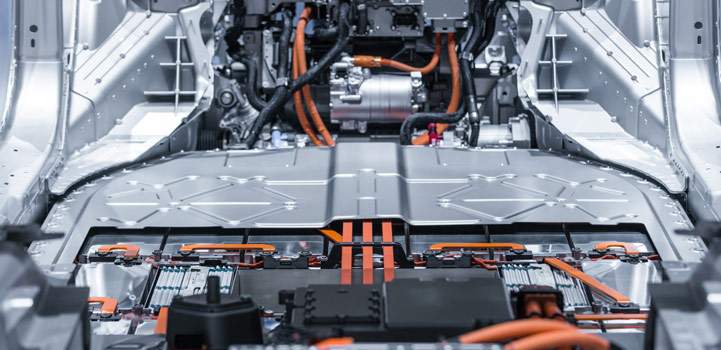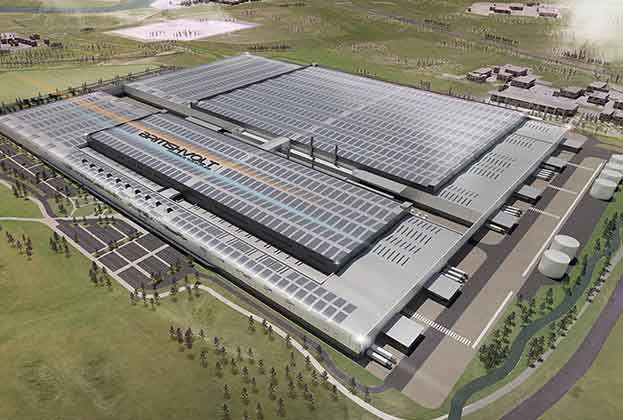Large-scale factories are required for the production of electric vehicles
Batteries included
Gigafactory – it’s one of the latest buzzwords being thrown around the Industrial and Logistics market, attracting a lot of interest. The term refers to the large-scale factories that produce rechargeable lithium-ion batteries, primarily for electric vehicles (EVs) at a gigantic scale. Elon Musk initially created the term for the name of Tesla’s manufacturing plants, the first and exemplar being the 1.9m sq ft Gigafactory 1 plant in Nevada. The process itself is incredibly complex and has many separate components throughout the manufacturing process – there’s also a need to undertake constant laboratory analysis and further research and development practices, which means it is far more economical to complete the process in one place requiring the factories to be very large.
Globally, we have seen a huge rise in efforts to tackle climate change that has the ability to alter human life as we know it. Treaties such as the Paris Agreement have been created which are legally binding goals to help tackle climate change. This particular treaty was adopted by 196 Parties at COP21 in Paris in 2015, with the goal to limit global warming to well below 2 degrees Celsius, preferably to 1.5 degrees Celsius compared to pre-industrial levels. EVs are a vital part to meeting these global goals on climate change as they produce no greenhouse gas emissions compared to internal combustion engines.
The United Kingdom has started to implement various policies and pieces of legislation that seek to reduce global greenhouse gas emissions, recently rumouring to announce a formal ban on the sale of new combustion-powered vehicles at an earlier than proposed date of 2030. Consequently, the demand for EVs is set to skyrocket.
Gigafactories will be required throughout the world to cater for the anticipated surge in EV production through providing the most critical component: the battery. As EV production has become more commonplace, it has become evident that over 40% of the EV’s value lies within the battery, making it the most critical part within the automotive supply chain.
The industry must begin to manufacture these batteries on a giant scale in order to drive down overall costs through economics of scale that will bring the price of EVs closer to traditional internal combustion cars. Moreover, to make the process viable, battery production should be located close to the EV production site – if the body production is on UK soil, then so should the battery plants.

Multiple new factories
Currently, the UK is still waiting to get out of the blocks when it comes to pushing Gigafactories. Our first has only recently been announced. However, the UK needs to secure multiple new factories to develop and scale-up new high-performance lithium-ion batteries if the sector is to continue to face the twin perils of tariffs in a no-deal Brexit along with the potentially prolonged economic fallout from the Covid-19 pandemic – this will help ensure automotive production remains in the country.
If the UK does not attract and develop a battery manufacturing industry, there is a risk that the production of EVs could move out of the UK and gravitate towards where the batteries are manufactured to shorten supply chains and making them more economical. Without UK battery manufacturing, the Faraday Institution estimates that car production in the UK would decline and there would be a potential loss of some 114,000 existing automotive jobs by 2040.
Strategically important
Recently, UK-based manufacturers such as Jaguar-Land Rover, Nissan and BMW have started lobbying the Government to help build more factories to support their efforts in swapping internal combustion engines that emit carbon dioxide for EVs with zero exhaust emissions. As such, the Department for International Trade (DIT) is working with the industry to help make the UK the location of choice to develop world-class EV technologies by looking to find a 4m sq ft site.
Putting the future battery requirement into context, Tesla alone noted that in order to ramp up production to 500,000 cars per year, the company would require today’s entire worldwide supply of lithium-ion battery production. This would only cover a fraction of the demand. According to US automotive sales, there are roughly 17 million new passenger cars and light trucks sold each year. The UK, in isolation, has seen around 2.3 million new cars registered per annum, again highlighting the global shortfall of lithium-ion batteries for EV manufacturing.
There is indeed a clear advantage to having Gigafactories on UK soil. Our first Gigafactory is set to provide numerous benefits – Britishvolt is committed to building a £2.6 billion facility in Northumberland. It will be up and running by 2023 and will operate at full capacity by 2027, by which time, it will be producing 300,000 lithium-ion battery packs a year, whilst creating 3,000 jobs directly and 5,000 in its wider supply chain to support production. The factory is strategically important for the UK automotive industry, and it will mark one of the largest UK industrial investments since 1984.
Finally, Gigafactories and the production of lithium-ion batteries are not just for EV production, but they are expected to take a central role in the UK’s effort to retool the economy for a fossil fuel-free world. Rechargeable batteries are starting to reach a size that would enable renewable energy sources to replace small-to-medium-sized natural gas generators that were traditionally charged by fossil fuels. Moreover, adding such storage makes renewable energy more profitable as one of the main challenges of renewable energy is that the more you put on the grid, the more the value declines. Storage helps deal with that by soaking up excess energy that would have been lost in the middle of the day, when electricity demand is lower, moving it to a time when it is more valuable.
Read the articles within Spotlight: Gigafactories below.
.jpg)


